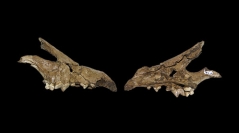

 Comptes Rendus Palevol
16 (7) - Pages 774-782
Comptes Rendus Palevol
16 (7) - Pages 774-782The North African fossil record of the family Canidae is scarce and scattered and for this reason poorly known. This is particularly true for the genus Canis , fossils of which only come from a few sites of Morocco and Algeria. Here, we provide the description of the first material of Canis from the early Middle Pleistocene site of Wadi Sarrat (Tunisia), recovered in association with other fossil mammal taxa and Acheulian lithic artifacts. A cranial specimen is described and compared to other fossil and extant canid species by anatomical and morphometric analyses. The specimen shows cranio-dental morphologies and proportions considerably different from other fossil and extant African canids. Remarkably, its proportions resemble more closely those of Eurasian Early-Middle Pleistocene taxa, e.g., Canis mosbachensis Soergel, 1925, although its principal morphological features cannot be referred to any of the known Eurasian taxa. Therefore, we suggest to ascribe this material to a new species of canid, Canis othmanii sp. nov. The presence of new species of Canis with Eurasian affinities in the northern part of the African continent has a high significance for the fossil record of this region, as well as strong implications on the paleobiogeography of canids during the Middle Pleistocene.
Canidae, Quaternary, Biogeography, Tunisia, Africa